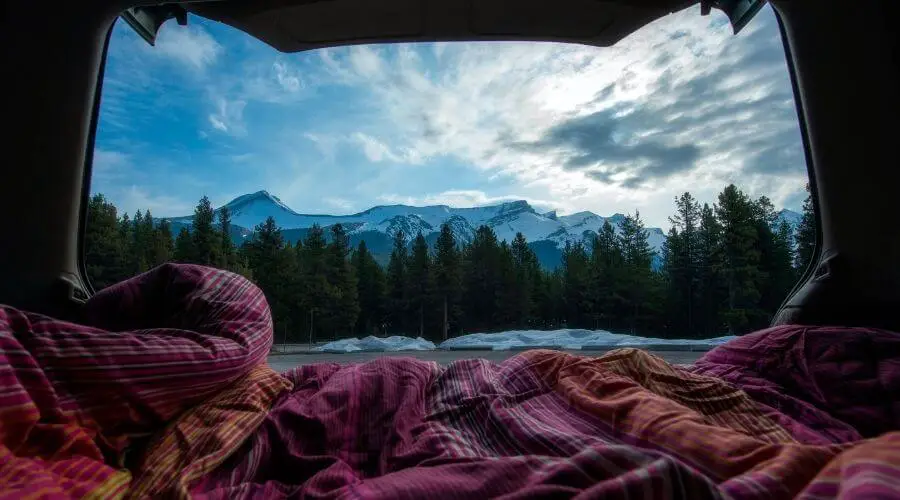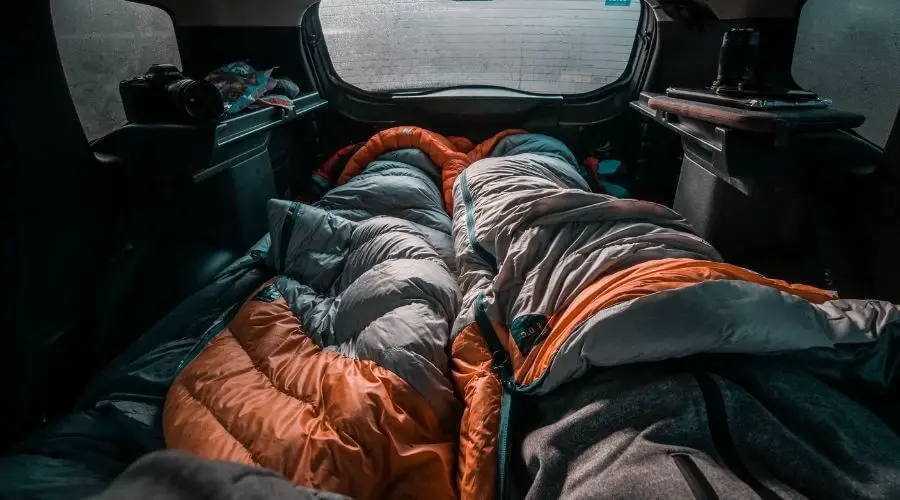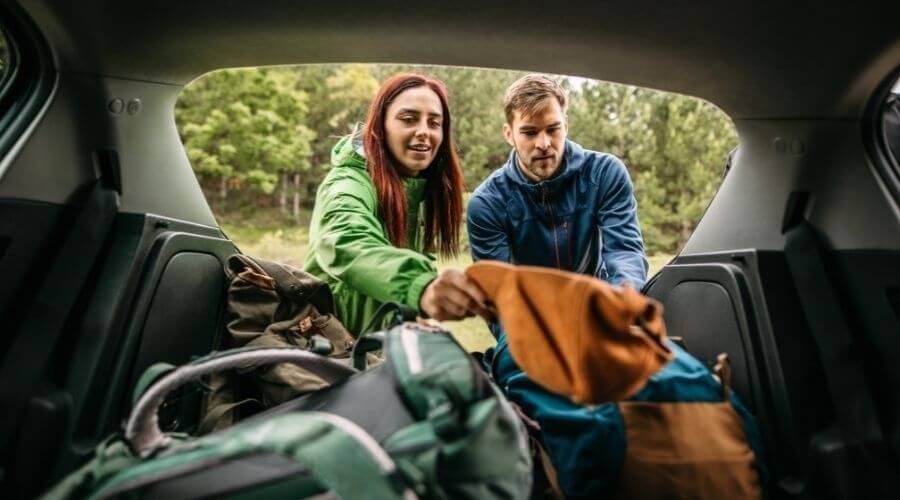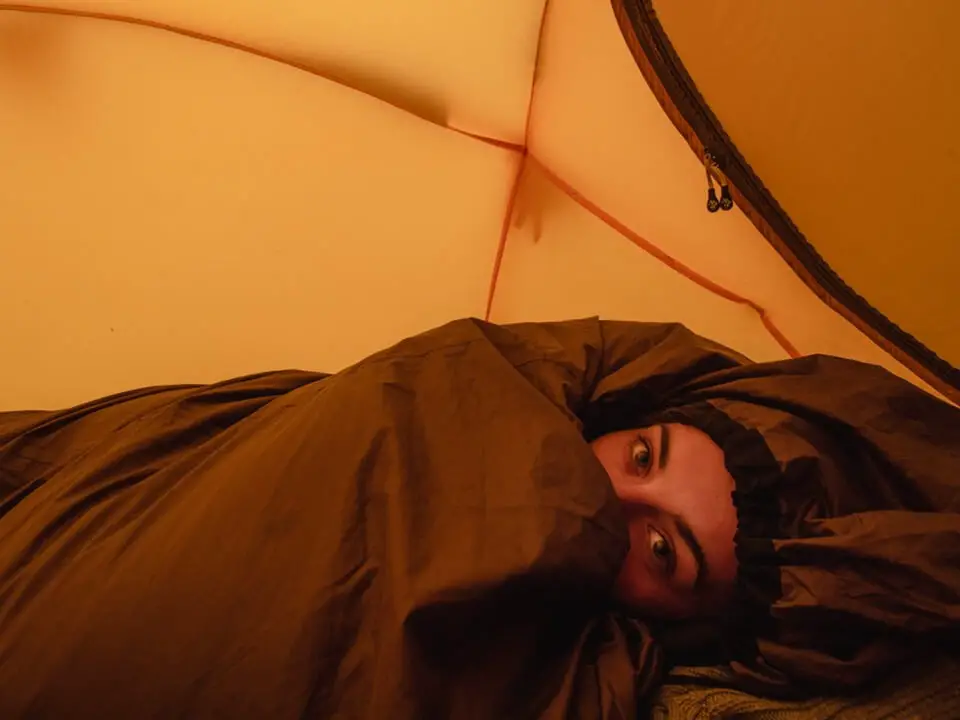
Car camping in the wintertime is not for the faint-hearted. You will need to prepare very carefully to avoid a cold and uncomfortable night’s sleep, but don’t worry. This article will give you 15 helpful tips to make the experience as safe and comfortable as possible.
15 Tips for Car Camping in the Winter
At the risk of being a party pooper, I recommend that you avoid camping in your car during the winter. Even with the best preparation, you will probably feel cold and perhaps uncomfortable.
Where possible, I suggest saving car camping for the summertime, when you can spend all day comfortably outside, and use your car just for sleeping.
Of course, there are some benefits to car camping.
For example, cars can get under height barriers that vans or RVs cannot. You will also be better protected from the wind and rain than you would be in a tent.
However, if you are determined to car camp in the winter, try a trial night next to your house before heading into the great outdoors.
This will allow you to test your sleeping bag and any other equipment, with the option of going back into the warmth if necessary.
In addition to warm clothing and blankets, you will want to bring a hot water bottle. I always bring at least two small hot water bottles and a travel kettle to plug into the cigarette lighter.
They make a huge difference in your body temperature and help warm up those frozen toes quickly. You can reuse the water from the bottles every night, so you don’t have to worry about using too much water.
If you are car camping in the wintertime, you do not want to get stuck in a snowdrift overnight.
For your safety, make sure that your tires are suitable for the season. Also, bring along some snow chains in the glove compartment.
You should use snow chains only when a considerable amount of snow and ice is on the road, as otherwise they will break. They may damage the road or your tires at the same time! However, when there is a lot of compacted ice or snow, chains are essential for your safety.
In case you are wondering, you need snow chains only on the drive wheels. It takes around 30 minutes to attach them once you’ve got the hang of it, so make sure you practice putting them on at home.
You don’t want to be working it all out in the freezing cold!
Batteries run out of power more quickly in the cold. They can also become irreparably damaged if the temperature drops too low.
When car camping in the winter, it is a good idea to protect your phone and any external battery chargers by storing them inside a warm sock. Insulating your batteries prevents them from suddenly running out, which could be dangerous if you break down in cold weather.
It may seem like the last thing you want to do, but by cracking open a window, you will prevent condensation from building up inside the vehicle when you sleep.
It is pretty awful to wake up to a sopping wet sleeping bag and water dripping off the ceiling. Trust me!
To be honest, by the time you wake up, your vehicle will be as cold as the ambient temperature, so there’s nothing to gain by keeping the window closed.
No matter how waterproof you think your boots are, they may eventually let in water.
If you spend the day hiking in the snow or rain, make sure you have something warm and dry to change into at the end of the day. If you keep putting on wet boots, you could end up with a fungal infection, as well as nasty blisters and frozen toes.
If your boots get wet and you don’t have a spare, you can place your feet in thin plastic bags from the grocery store before putting your shoes back on. It isn’t very comfortable, as your feet will get hot and sweaty without any ventilation, but it’s better than getting frostbite!
Just make sure to change your socks and apply antifungal cream every day in this circumstance, to prevent infections.
Considering that your car will be as cold as a tent by the end of the night, when preparing your kit imagine that you are dressing for tent camping. This will help you to pack the right level of warm layers.
You would be amazed at what a difference a few hundred feet can make. If you spend the days hiking or skiing in snowy mountains, don’t hesitate to drive to lower ground to spend the night.
A 10-minute drive down the mountain can make several degrees of difference in ambient temperature, for which you might be grateful.
If a lot of snow is forecast, make sure you park in a safe place where the roads will be serviced. You do not want to wait for a snowstorm to start before you begin driving, as visibility will be low and you could end up driving off the road.
Just keep a close eye on the weather. If in doubt, head somewhere safe in plenty of time.
For your safety, you should bring a foil emergency blanket when car camping. They are affordable, lightweight, and small enough to fit inside your pocket.
Use foil blankets only in an emergency because they are not at all breathable. This means you will wake up in the morning wet with sweat and condensation, which is not very hygienic or comfortable.
However, if this prevents you from getting hypothermia, it is most definitely worth it.
You will burn a lot more calories in the cold, so you need to eat plenty of food.
It is a good idea to bring expedition-style food, to which you need to add only boiling water. In bad weather, you can simply use the camping kettle I mentioned before to heat the water, so you don’t have to set up your cooking equipment outside in a storm.
In case of any problems with your kettle, you should also bring food that doesn’t need to be cooked, such as nuts, dried fruits, and, of course, chocolate.
If you are camping in cold weather, you will probably want to be as close to a public restroom as possible. You can use an app like MAPS.ME or park4night to help you find a convenient parking place near a toilet.
It is also possible to get a portable urinal to use in your car. These are essentially large plastic bottles with wide mouths. They should be emptied responsibly, not poured out in the parking lot, which is happening more and more often and causing authorities to crack down on car camping.
If you have to go to the toilet in the great outdoors, bring a small shovel and bury your business a good distance from paths and water sources. Toilet paper should be thrown in the bin, not left outdoors.
Any damp clothes and towels will soon begin to smell bad. They can also get moldy and contribute to more condensation.
So, you should bring a simple washing line with you in the car. If you get any sunny days, you can quickly tie the line between a couple of trees and dry out some of your kit.
Alternatively, get to the launderette at least once a week to wash and dry any damp clothing or towels.
The best style of sleeping bag for winter camping in your car is a mummy sleeping bag. These have a warm hood that you can pull over your head and then pull tight with the elastic and toggles.
These are better-insulated than a classic sleeping bag without a hood because warm air can’t escape from the gap around your neck and shoulders.
If the weather is too bad to go for a walk, I recommend driving to a big store and walking around the aisles.
This might sound boring, but it’s crucial to move your body when you’re spending time in such a cramped space. Otherwise, you will soon find that your spirits drop and your joints begin to ache.
Many non-grocery stores will also let you bring your dog inside; just call in advance to check whether it’s OK. For example, Tractor Supply, Lowes, and Camping World normally welcome well-mannered dogs on a leash.

How to Insulate Your Car for Winter Camping
It is unrealistic to think that you can insulate your car successfully, especially considering that you have to open a window to prevent condensation.
Heat is lost through the floor, the walls, the windows, and the roof, so even if you can insulate parts of the vehicle, you still won't be able to keep your car warm.
So, forget about trying to insulate your car and instead focus on insulating your body. This will save you a lot of time and money as well as guarantee a better night's sleep.
I recommend that you buy the best-quality mummy sleeping bag that you can afford, wear lots of warm layers, including a hat, and bring hot water bottles with you.
Hot water bottles last much longer than snap heat packs, and they don’t contain toxic chemicals. Put snap heat packs in your first aid kit only as emergency pieces of equipment.
The rest of the time, rely on the more effective and environmentally friendly hot water bottles.
Why Living in Your Car in the Winter Is Bad
Living in your car in the winter is not ideal.
You won’t have enough space to stand up or move around, which will make you feel very cramped and uncomfortable when the weather is bad. You can also expect to frequently feel cold, and have very limited facilities to cook, clean yourself, or go to the toilet.
However, not everybody has another option, and car camping can be safer and more comfortable than sleeping in a tent for the winter.
Keeping clean will be one of your biggest challenges, but you can always pay for a shower at a truck stop if necessary.

Car Camping Essentials for Car Camping in Cold Weather
Packing the right car camping essentials can make the difference between a miserable experience and a warm and comfortable night’s sleep.
However, this isn’t only about comfort. For your health and safety, you must be appropriately prepared for the weather conditions and have enough supplies to hunker down if the weather takes a turn for the worse.
For more information on winter car camping gear, check out our checklist.
FAQs About Sleeping in Your Car During Winter Season
Do you have to crack a window when sleeping in your car?
It is an excellent idea to crack open a window, as otherwise you will wake up to a car dripping with condensation. This is not very hygienic or comfortable and can lead to foul smells and mold in your vehicle.
You can keep the windows closed if you want, but make sure to open all the doors and windows so the car can dry out the next day. Also, keep all food and clothes in waterproof containers.
How cold is too cold to car camp?
This depends on your kit and personal resilience. Just as some people tent camp in the arctic, some people are happy to car camp in extreme conditions. It’s a good idea to practice cold weather car camping at home, so you know what to expect on your trip.
Is wild camping in your car legal?
It depends on the country you are in, and even on the zone within different cities. You will need to do some research for your specific location. If you need help finding a spot, you can use apps like Overnight RV Parking or park4night.
Conclusion
Car camping in the winter may not be particularly comfortable but it can be a much better alternative to tent camping in the cold season.
If you decide to car camp in the winter, make sure to prepare as if you will be camping in a tent, as this will help you pack appropriately.
The better you prepare, the more safe and comfortable your experience will be!
Do you have any useful tips for car camping in the winter? Please leave a comment below; we would love to hear from you!
More to read:
About the author
Rachel is a freelance adventure writer and founder of Highly Sensitive Nomad. When she isn’t writing, she can be found wild camping in the mountains and swimming in the lakes of Europe.

